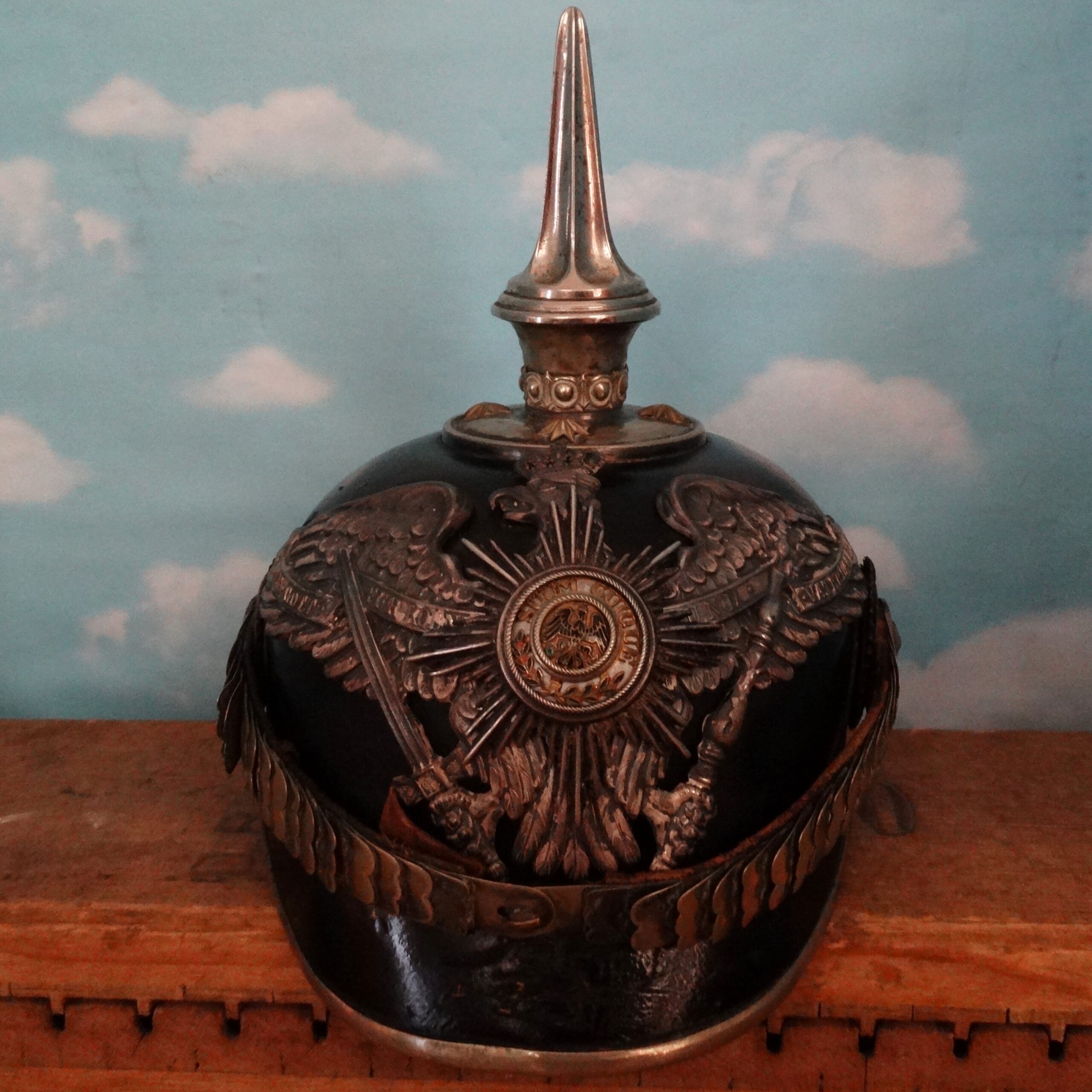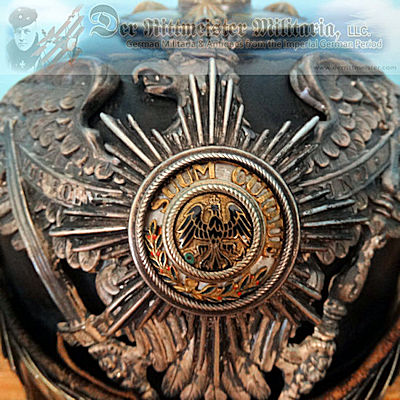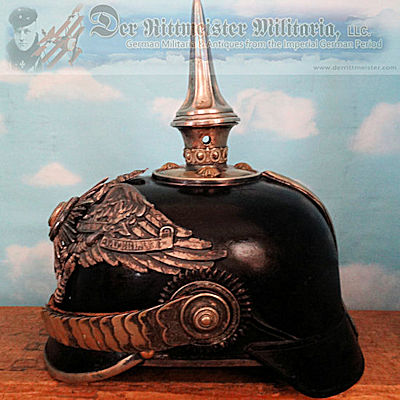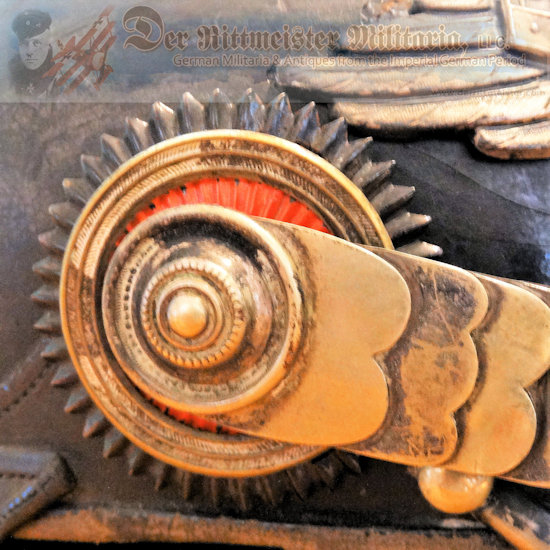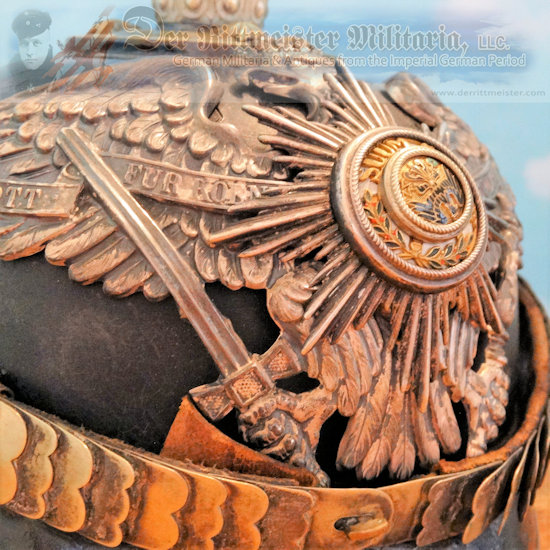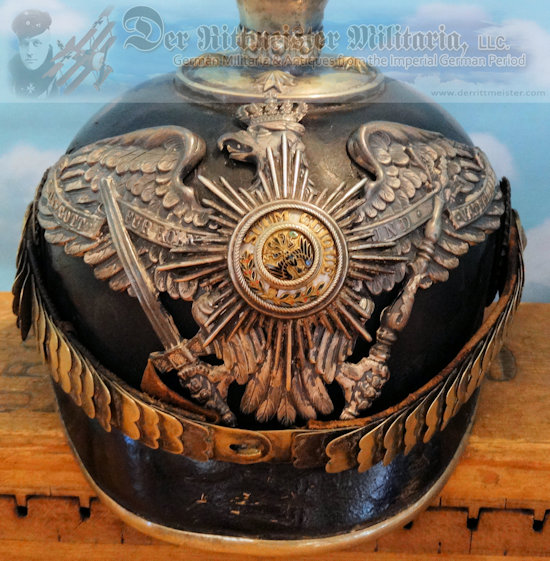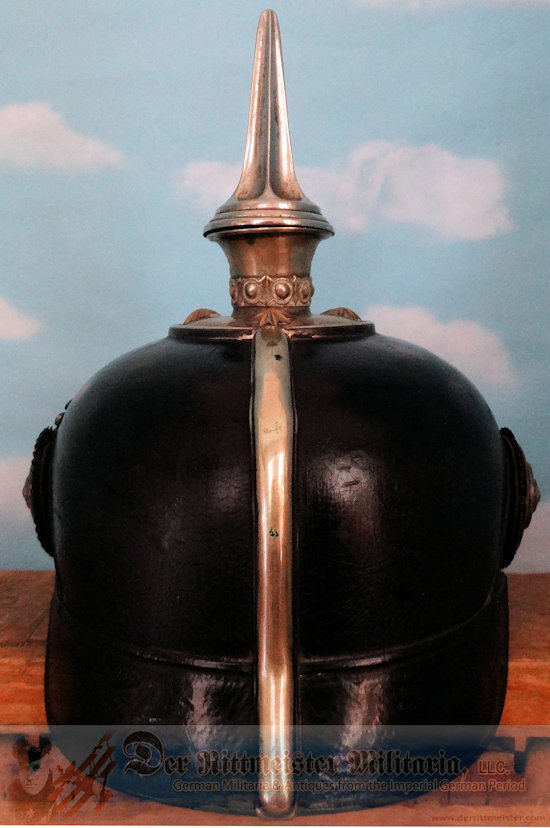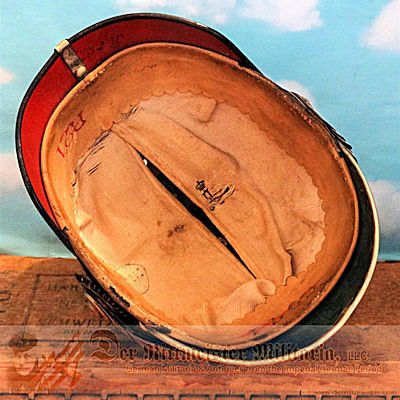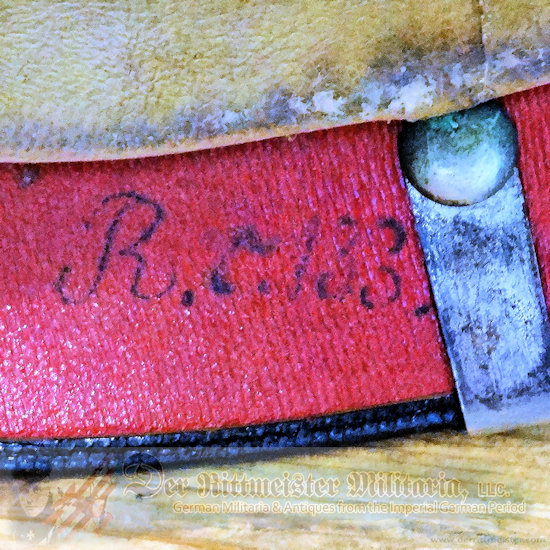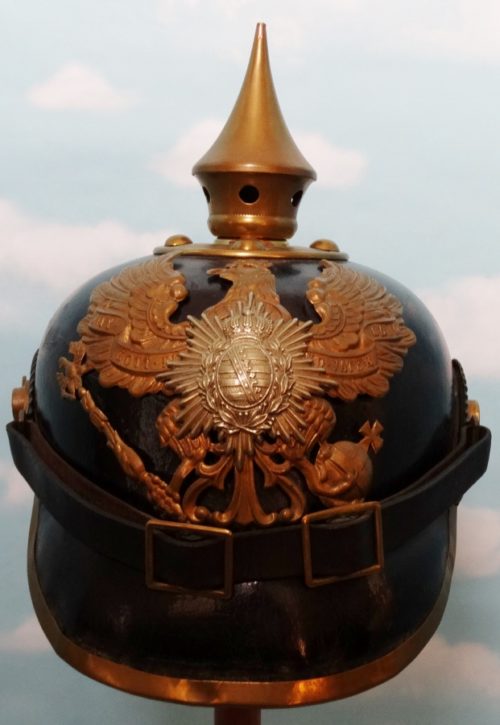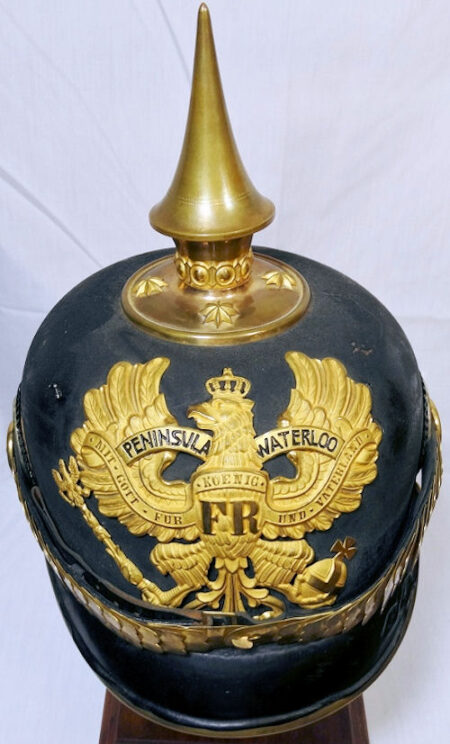Description
PRUSSIA – PICKELHAUBE – OFFICER’S -1. GARDE REGIMENT zu FUß – ATTRIBUTED TO PRINZ ADALBERT.
This is a simply delicious 1. Garde Regiment zu Fuß officer’s spiked helmet. The regiment was the most elite among Prussia’s and Germany’s Infanterie Regiments. It was garrisoned in Potsdam with its Kavallerie Regiment counterpart, the Regiment der Garde du Corps. The regiment was loaded with denizens of Imperial Germany’s highest royal and noble families. Every Hohenzollern Prinz was invested in it, including all of Kaiser Wilhelm II’s sons, just as the Kaiser himself had been as a young man. The Kaiser also served as its Regimental Chef. The latter was a ceremonial post since every regiment that possessed a royal patron actually was run on a daily basis by its true commander, typically an Oberst or Oberstleutnant. [Please remember that the 1. Garde Regiment zu Fuß also was notable as one of only two Prussian Infanterie Regiments to retain the Mitre as its headdress for high dress occasions. The Mitre had been the Infanterie’s preferred headdress prior to the pickelhaube’s introduction in 1842. After that date, all the other regiments switched to a combination of pickelhauben, schirmmützen and mützen for their headgear].
This particular 1. Garde Regiment zu Fuß officer’s pickelhaube once belonged to Prinz Adalbert, one of Kaiser Wilhelm II’s six sons. These six sons (and one daughter) were Kronprinz Wilhelm (1882 1951), Prinz Eitel Friedrich (1883 1942), Prinz Adalbert (1884 1948), Prinz August Wilhelm (1887 1949), Prinz Oskar (1888 1958), Prinz Joachim (1890 1920), and Prinzessin Viktoria Luise (1892 1980). Adalbert was the only son of Kaiser Wilhelm II to serve in the Navy rather than the Army. His career was NOT particularly noteworthy. During WW I, he served first on the battleship S. M. S. Kaiser. He then served as the commander of the S. M. S. Danzig (II), a Kleiner Kreuzer, from May 1917 to March 1918. His final command aboard the S. M. S. Dresden, another Kleiner Kreuzer, lasted from March 1918 to the war’s end in November 1918. [An interesting aside: the S. M. S. Dresden was the last major vessel that was commissioned during the war].
The magnificent helmet’s body is quite pleasing. Its leather is generally supple with no major flaws to its surface. It is clean and in excellent condition for being more than one hundred years old. Its silver body furniture is correct for the 1. Garde Regiment zu Fuß, including the wappen, chin scales, base with pearl ring, helmet trim and spike. The fluted spike differs greatly from most pickelhauben spikes, lending it a very elegant look. The correct State and Reich’s kokarden are also present.
The wappen, however, is the true star here and deserves special attention. First, we can tell that the helmet is correct for the 1. Garde Regiment zu Fuß. [PLEASE NOTE: The Regiment’s Battalion Nr 1 and Regimental Staff Officers wore “Semper Talis” bandeaux above the eagle. This helmet does not sport that bandeau, so either of the two princes was assigned elsewhere. (We do have a very fine pickelhaube coming up soon from Battalion Nr 1 of the 1. Garde Regiment zu Fuß that does display the “Semper Talis” bandeau)].
The helmet’s wappen boasts a fine, heavy patina. Such a patina adds an extra level of beauty to an item. While it may not actually be .800 silver (although the Hohenzollern family certainly could have afforded it), at the very least it certainly is German Silver. Its massive eagle displays wings that extend PAST its kokarden. When you first look at the helmet, it seems as though these wings go on forever. The center of the eagle’s chest displays the Garde Star that decorates all Garde Regiment headdresses. This Garde Star exhibits a rich layering of red, white, black, and gold enamel. The Garde Star’s center displays a multicolored Black Eagle.
The Order of the Black Eagle is the House of Hohenzollern’s highest order. Certain levels of this Order were invested to all its House’s young princes. [Also, at the discretion of the King or (later) Kaiser, others NOT born to the House of Hohenzollern could be awarded this special honor. It was more of a royal honor than a direct military award]. As not only Prussia’s, but Imperial Germany’s most elite Infanterie Regiment, the 1. Garde Regiment zu Fuß was packed from top to bottom with royals and nobles from all over Germany. Aside from those on active duty, more than twenty eight royals were assigned to it as à la Suite officers. Every House of Hohenzollern male was invested in it as a Leutnant at a young age. As they all grew older, they were promoted to higher ranks (depending on their individual situations). Kaiser Wilhelm II’s younger brother, Prinz Heinrich, in addition to being a Kaiserliche Marine Großadmiral, was a Generaloberst in the Rank of Generalfeldmarschall in the 1. Garde Regiment zu Fuß. Since this was the policy, Prinz Adalbert served in the 1. Garde Regiment zu Fuß.
The helmet’s interior features a well worn beige/cream leather sweatband. It also displays what I believe are museum marks that could have been used for inventory purposes: “R21” and “Pb63.” The later number is crossed out, which indicates [to me] that the first number was the most current inventory designation. Another series of letters and numbers appears on the helmet’s back visor. Now we come to the proof that Adalbert owned this helmet. In the (again soiled) cream silk liner’s center is a black “A” beneath the Hohenzollern Crown, Prinz August Wilhelm’s cypher. The silk beneath the lower part of the cypher is shredding. Several other liner sections sport shredding, and the entire liner and sweatband exhibit soiling from what probably was a combination of sweat and hair oil. This helmet DEFINITELY was worn!
Underneath that silk liner, we find that ALL of the hardware is 100% original to the helmet, extending to where the base, pearl ring, and spike are connected at the interior’s top. The same applies to the wappen’s securing hardware, which is original. Of course, NO double holes are present where it is secured.
This is a fascinating helmet that once belonged to one of Kaiser Wilhelm II’s sons. It would make an excellent addition to any headdress or royalty collection.
At Der Rittmeister Militaria, we strive to bring you the best in spiked helmets, or pickelhauben (plural for pickelhaube), one of Imperial German Militaria’s most interesting areas for collecting. While ORIGINALITY and AUTHENTICITY are of prime importance, please do not forget Der Rittmeister’s commitment to CONDITION and QUALITY. In this regard, we take special pride in offering you spiked helmets whose condition is at least well above average, if not excellent. I examine hundreds of pickelhauben to find the very few that fulfill all four criteria mentioned above. Upon receiving their new treasure, collectors who have purchased one of our pickelhauben often exclaim that their helmet looks even better than the photos we had displayed on our website. [We do use a high quality digital camera to photograph our items and upgrade cameras every two years, but enough with the Der Rittmeister Militaria commercial]! Just remember, dear friends, Der Rittmeister’s Four Critical Criteria for collecting pickelhauben: ORIGINALITY, AUTHENTICITY, CONDITION, and QUALITY.
The pickelhaube was designed in 1842 by Prussia’s König Frederick William IV for use in the Prussian Infanterie. [The Prussian king might have copied similar helmets adopted by Russia’s military during the same time period. It is not clear whether this was a case of imitation, parallel invention, or if both were based on Napoleonic cuirassiers’ helmets]. The helmet style was soon adopted by Germany’s other states and kingdoms during the mid 19th Century, with Bavaria being the final principality to implement it in 1886. [The Bavarians always seemed to go their own way! Interestingly, Bavaria was also the last to authorize kugelhelme for their Artillerie Regiments in 1913]. In addition to Russia, spiked helmets were adopted by many Latin American countries. They were even worn by the USA’s armed forces from the 1880’s until around 1910.
We also remind all pickelhaube enthusiasts about our good friend Jim Turinetti’s excellent reference books on the subject (click here to see DRM’s Imperial German Headdress Page Nr 3), available as spiral bound paperbacks or on CD. You cannot go wrong with them. I can safely state that Jim is the USA’s foremost authority on pickelhauben. Please support him. Dollar for dollar, these books are the best on the market, and reward you with an immeasurable return in value! [Remember, Jim receives any and ALL the profits from his works, Der Rittmeister Militaria just promotes them to help educate the collecting community].
